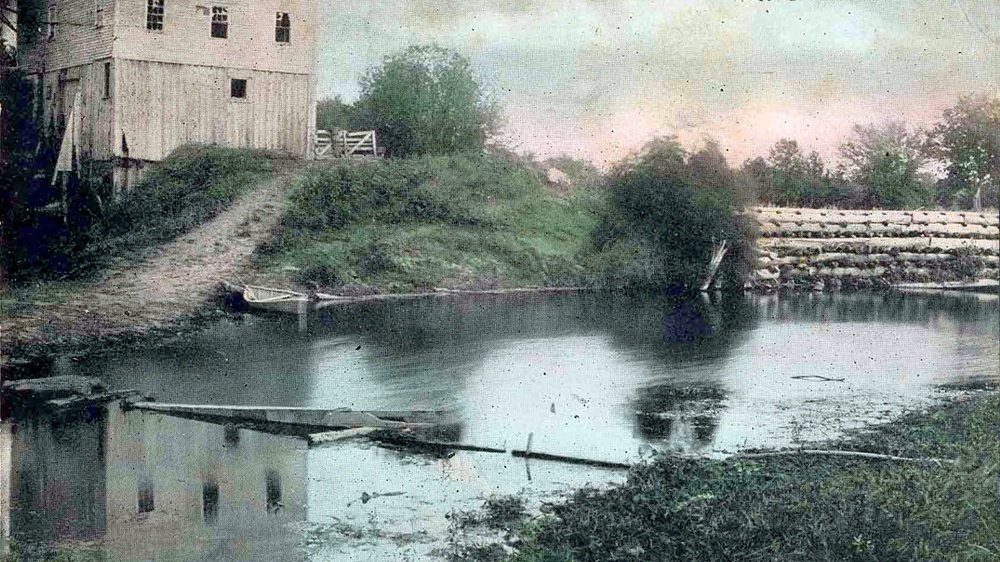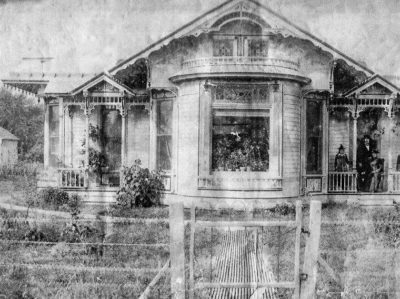The Mysterious Death of Clara Ober in Blue Earth
After 120 years, the mystery of what happened to Clara Ober between the evening of July 29th, 1895, and 2:00 p.m. the following day remains unknown. The entire community around Blue Earth, Minnesota was divided about what happened to Clara and who was responsible for her death. In fact, it is still debated today.
Clara Ober was the second oldest child of German immigrants, George and Amanda Ober. The couple arrived in Blue Earth around 1870. George got a job as a carpenter and they started a family shortly after settling in. The couple had eight children before George’s sudden death on Christmas day in 1890 at the age of fifty. Amanda was several months pregnant at the time of George’s death and suffering from depression. Clara was only sixteen. She moved in with saloon and restaurant owner Jacob Freund and his family, who lived just a few blocks away.Although the reason for her move into the Freund home was never reported, she may have worked as a nanny for their two children.
Jacob Freund operated a successful saloon and restaurant in Blue Earth. In 1890, he built a Queen Anne style cottage on the 200 block of Galbraith Street for his wife, Sadie, and their two children, Pearl and Otto. Clara lived in the house with the family until 1895 when she begged her uncle, Henry Eberlein, to allow her to move into his home on Fourth Street. He agreed and helped find Clara a job as a dressmaker.
When Henry walked passed Clara’s bedroom just before dawn on July 30th, he noticed that she was not in her room and that the quilt from her bed was missing. He called out to her, but there was no answer. Henry went into her bedroom to look for a clue about where she might have gone so early in the morning. He found a note beside her bed that indicated Clara may have left the home with the intent of killing herself. The only thing missing from her room was the quilt from her bed, which her uncle assumed she used to wrap around herself due because it appeared that all of her clothing was accounted for.
Clara’s family notified the police and fanned out in search of her. By noon there was still no sign of Clara. Word quickly spread around town that a young lady was missing. The police sounded the fire whistle to gather residents to help with the search. Groups were sent out in every direction. When she was found, the group was supposed to send word to the city engineer who would then sound the fire whistle three times in a row. Within an hour, the three whistles rang out.

Clara’s body was found floating face down in the Blue Earth River near the old mill at 2:00 p.m. on July 30, 1895. One of the members of the search party immediately set off to notify the Conings brothers, who ran the funeral home in town, and to bring coroner Dr. Humes to the scene. Dr. Humes was away visiting family on the east coast so he appointed Dr. Franklin to the case.
Meanwhile, authorities began interviewing people close to Clara with the hope of finding out what happened to her. Her uncle was understandably distraught over the death of his niece. He told police about the circumstances that brought Clara to live with him that spring. He reported that Clara had been having trouble at home after her father’s death. Her mother was pregnant and suffering from depression. Jacob and Sadie Freund befriended Clara during this time and offered to let her live with them. During the five years that Clara lived with the Freund family, she had almost constant trouble with them. Henry said that Clara repeatedly told him and several of her friends that Jacob Freund and his family had ruined her life. Henry also reported that Clara had been suffering from depression and extreme anger over her ruined reputation at the hands of the Freund family. Police reported that several people they interviewed voiced their suspicions about Jacob seducing Clara, possibly against her will, and that the relationship may have resulted in a pregnancy.
After conducting their initial interviews, police issued a warrant for the arrest of Jacob Freund at 10:00 p.m. on July 30th. He was arrested shortly afterward. A group of men looking for justice smashed the windows of Jacob’s saloon, destroying everything inside, and were threatening to set his house on fire. Thankfully, cooler heads prevailed and the crowd disbursed before midnight.
The following morning, police asked witnesses to come forward if they had any information regarding Clara and Jacob’s relationship, or their whereabouts during the early morning hours of July 30th. Several parties came forward with information.
Clara’s 13-year-old brother, Arthur Ober, still lived with their mother next door to Henry’s home. Arthur reported that he often saw Jacob enter Henry’s house through the back door, take Clara into another room, and lock the door behind them. From his vantage point, he wasn’t able to see what happened between Clara and Jacob in that room. He also stated that when he mentioned what he had seen to Jacob, he offered Arthur a quarter to keep quiet about the visits—which he did.
Henry reported that the quilt from Clara’s bed that he believed she wrapped around herself when she left the house still hadn’t been found. His wife looked through the entire house before declaring it missing. The blanket also wasn’t found in the river with Clara’s body or anywhere nearby. He concluded that whoever murdered Clara must have the quilt. Interestingly, after Clara’s body was found, Henry never mentioned the note he found in Clara’s room that led him to believe she had left the house with the intent of harming herself. There is also no evidence that authorities asked to see the note.
Louis Newman lived near the old mill where Clara’s body was found. He reported to police that he heard two screams on the night of July 30th, followed by a third that was cut off. He said that he didn’t think anything of it because his dog didn’t bark at the noise. It wasn’t until the next morning that he noticed that his gate was open and all of his animals, including the dog, had escaped. He concluded that the dog probably wasn’t in the yard at the time he heard the screams. He also reported that his 12-year-old daughter had been taking the cows to pasture around 8:00 a.m. the morning Clara disappeared. She saw a piece of cloth in the river near the mill and said that she witnessed Jacob Freund walking away. The girl ran home immediately. A couple of hours later, the girl and a friend went back to the river to throw sticks and stones at the object to see if it would move. The children didn’t find out what the object was until they watched Clara’s body being pulled from the river.

This eyewitness account put Jacob at the scene of the crime. By the time the coroner’s report came back on August 7th, residents had begun to strongly favor the murder theory. The following day, the Blue Earth City Press printed the findings of the autopsy. Clara’s lungs were partially filled with water, leading to a verdict of death by drowning. The reporter pointed out that the coroner’s verdict didn’t prove or disprove voluntary drowning. However, the coroner’s report also indicated that the position in which Clara’s body was found lead him to believe that she was either unconscious or stunned before she drowned. That would explain why her lungs were only partially filled with water. The report also stated that there were bruises around Clara’s neck and on her face. People who favored the murder theory said that they were likely caused by someone’s fingers as they strangled Clara before tossing her into the river, or by holding her under the water as she drowned. The opposing side said that the bruises were due to other objects in the water striking the body or post-mortem lividity. The coroner’s report specified that Clara was not pregnant at the time of her death, but that he wasn’t able to rule out pregnancy in the past.
With the evidence against Jacob stacking up, the case went to trial in Fairmont (Martin County) in 1896. The process of finding unbiased jurors proved to be extremely difficult due to widespread speculation throughout the entire area. When 12 jurors were finally selected, the trial commenced. The prosecution claimed that Jacob murdered Clara in an attempt to cover up their affair, while the defense maintained that she was severely depressed after leaving Jacob’s home and took her own life.
Jacob Freund took the stand in his own defense and accounted for his whereabouts on the night Clara disappeared. He testified that he had last seen her on the evening of July 30th when she left her uncle’s home with a girlfriend. Later, Clara’s doctor took the stand and relayed to the jury that Clara suffered from “depression with melancholic features” and that he had been treating her with nux vomica*.
After deliberating for more than forty hours, the trial ended in a hung jury—eight jurors voted to convict Jacob, four to acquit. A second trial was ordered for the same location, but with a different judge and jury in the spring of 1896. Again, the jury couldn’t come to a unanimous decision. The judge gave them further instructions and asked them to deliberate a while longer. The general public was convinced that the jury would come back with a conviction. However, they returned a unanimous verdict of not guilty.
After being released from jail, Jacob was nearly bankrupt. He operated a saloon in Mankato for a short time and people there believed his innocence. He eventually moved his family back into their Queen Anne style cottage in Blue Earth. The unrelenting pressure placed on the family by a community convinced that he was guilty of murdering Clara Ober proved to be too much for Jacob. At 7:00 a.m. on January 17, 1898, Jacob put a pistol to his head and pulled the trigger.
The acquittal of Jacob Freund in 1896 reignited the debate as to whether Clara Ober carried out her own death or if she was murdered—and if it wasn’t Jacob Freund, then who did it? Many questions remain unanswered to this day. For more than one hundred and twenty years, Clara’s death has remained one of the most highly debated, unsolved deaths in southern Minnesota.
*Today, nux vomica is used as rat poison. It contains strychnine and brucine—two deadly chemicals. It is still occasionally used in very low doses in humans. Side effects include restlessness, anxiety, dizziness, neck and back stiffness, spasms of jaw and neck muscles, convulsions, seizures, breathing problems, liver failure, and death.
